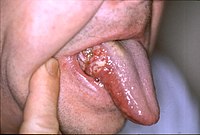
Photo from wikipedia
Although the prevalence of human papillomavirus (HPV)-related oropharyngeal squamous cell carcinoma (OPSCC) is increasing in developed countries and becoming a relevant health issue, the natural history of oral HPV infection… Click to show full abstract
Although the prevalence of human papillomavirus (HPV)-related oropharyngeal squamous cell carcinoma (OPSCC) is increasing in developed countries and becoming a relevant health issue, the natural history of oral HPV infection is still unclear. Estimating the infection’s prevalence in specific populations and identifying risk factors can widen our understanding of its natural history and help to delineate appropriate prevention strategies. This study sought to (i) determine oral HPV prevalence and genotype distribution in a large series of young Italian adults, (ii) validate an oral rinse sampling/storage protocol, and (iii) pinpoint factors associated with oral HPV infection. Five hundred students, nurses, and technicians (19–35 years-old) studying and working at/for the University of Padua were recruited. Each participant was provided with an oral rinse sampling kit and instructions for use. They were also asked to complete an anonymous questionnaire concerning their demographic characteristics and behaviors. The questionnaires and oral rinse containers were labeled with the same identification code number. The oral rinse samples were tested using a bead-based multiplex BSGP5+/6+-MPG genotyping assay which amplifies the L1 region of 51 mucosal HPV types. The prevalence of oral HPV infection was 4.0% (95% confidence interval (CI), 2.5%-6.1%); those of 14 high-risk HPV types and of HPV-type 16 (HPV16) infection were 2.2% (95% CI, 1.1%-3.9%) and 1.6% (95% CI, 0.6%-3.1%), respectively. HPV16 was the most frequent genotype (40.0% of oral HPV infections). No association was found between oral infection and the co-variables studied (gender, tobacco, alcohol and illegal drug use, number of sex and oral sex partners, HPV vaccination status, history of HPV and sexually transmitted infections, abnormal pap smears, recurrent tonsillitis and tonsillectomy). The oral rinse sampling protocol outlined here proved to be simple, efficient and well tolerated, and the prevalence rate can be considered reliable and thus useful to guide future research. Determinants of oral HPV infection are still unclear and further studies are certainly warranted.
Journal Title: PLoS ONE
Year Published: 2017
Link to full text (if available)
Share on Social Media: Sign Up to like & get
recommendations!